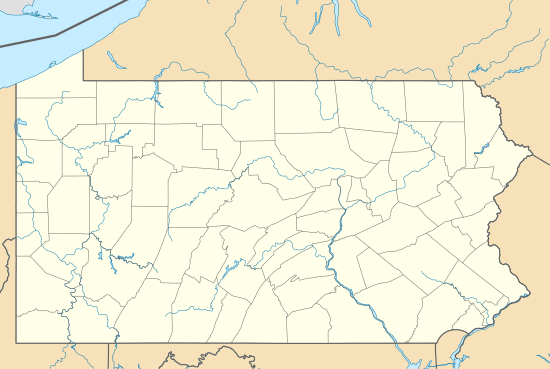Enola Yard


Enola Yard is a large rail yard located in East Pennsboro Township, Pennsylvania, along the western shore of the Susquehanna River at Harrisburg, Pennsylvania. It was the world's largest freight yard through 1956.[1] The yard continues to operate today at lower traffic levels. Coordinates: 40°17′41″N 76°55′31″W / 40.294666°N 76.925336°W
History
The yard was built by the Pennsylvania Railroad (PRR) in 1905 with two hump classification yards.[2] Initially the yard processed 7,000 cars per day. The westbound complex had a receiving yard with 20 tracks, and a 25-track classification yard. The eastbound complex had a 21-track receiving yard and 17 classification tracks. There were no separate departure yards.[1]
Enola Yard was fully built out by the late 1920s, encompassing 316 acres and a capacity of 9,692 cars. Service buildings included a 43-stall roundhouse and a steel car shop. A yard to handle container freight was added to the complex in 1932.[3]
The PRR rebuilt the component yards and installed automatic retarders, starting with the eastbound hump in 1938. The eastbound yard was electrified with 11,000-volt alternating current (AC) service.[3] (See Amtrak's 25 Hz traction power system.) The westbound complex was rebuilt in 1944 with 16 receiving tracks and 35 classification tracks, followed by the eastbound complex, reconfiguring to 15 receiving tracks and 33 classification tracks. The average daily traffic load in 1939 was 11,207 cars, and this average increased during the approach of World War II, with 14,100 daily cars in October 1941. The record traffic level at the yard was 20,660 cars in one day during June 1943.[1]
A diesel locomotive shop was added in the late 1940s.[3] In 1953 the yard handled 11,000 cars per day,[1] and the yard comprised 145 miles of track and 476 switches.[4] In the 1950s PRR rebuilt Conway Yard near Pittsburgh, and upon its opening in 1959, Conway became the railroad's major yard for east-west traffic. Traffic at Enola Yard was reduced.[3]
Conrail took over operation of Enola Yard in 1976. Traffic levels at the yard declined as more trains were routed by Conrail over nearby tracks of the former Reading and Lehigh Valley rail lines.[1] Conrail removed electrification equipment and closed the eastbound hump yard in 1983, and closed the westbound hump yard in 1993. The steel car shop closed in 1996.[3]
Current operation
The yard is currently owned by the Norfolk Southern Railway (NS), which has operated a flat classification yard and increased operations since taking over from Conrail in 1999. In 2003 NS announced plans to resume hump yard operations.[5] As of 2005, the yard was operating 79 tracks and handled 275,000 tons of freight a day.[6]
Facilities (at peak operation, mid-20th century)
The facilities, at its peak in the mid-20th century, had an engine house with 46 stalls and 2 turntables. It had two classification yards, one for east bound and one for west bound traffic, each with a hump yard with 2,668 car capacity. The East-bound receiving yard had a 1,948 car capacity and the west-bound receiving yard had a 1,721 car capacity. The container yard had 140 car capacity.[2]
See also
- Enola Branch (Norfolk Southern Railway)
- List of rail yards
References
- 1 2 3 4 5 Rhodes, Michael (2003). North American Railyards. Minneapolis, MN: MBI Publishing. p. 165. ISBN 978-0-7603-1578-1.
- 1 2 Alexander, Edwin P. (1967). The Pennsylvania Railroad: A Pictorial History. New York: Bonanza Books. p. 133.
- 1 2 3 4 5 Pennsylvania Department of Transportation, Harrisburg, PA (1997). "Enola Yard: A Brief History." Brochure.
- ↑ Kraft, Edwin (June 2002), "The Yard: Railroading's Hidden Half." Trains Magazine, Vol. 62, No. 6, p. 48.
- ↑ Harrisburg's historic Enola Yard is railroad hub Brotherhood of Locomotive Engineers and Trainmen, press release. 2003-10-13. Retrieved 2010-05-26.
- ↑ Doody, Angela (2005-01-21). "Enola Yard still strong". Central Penn Business Journal. Harrisburg, PA: Journal Publications. ISSN 1058-3599.